2019 TOYOTA SUPRA roof
[x] Cancel search: roofPage 8 of 456
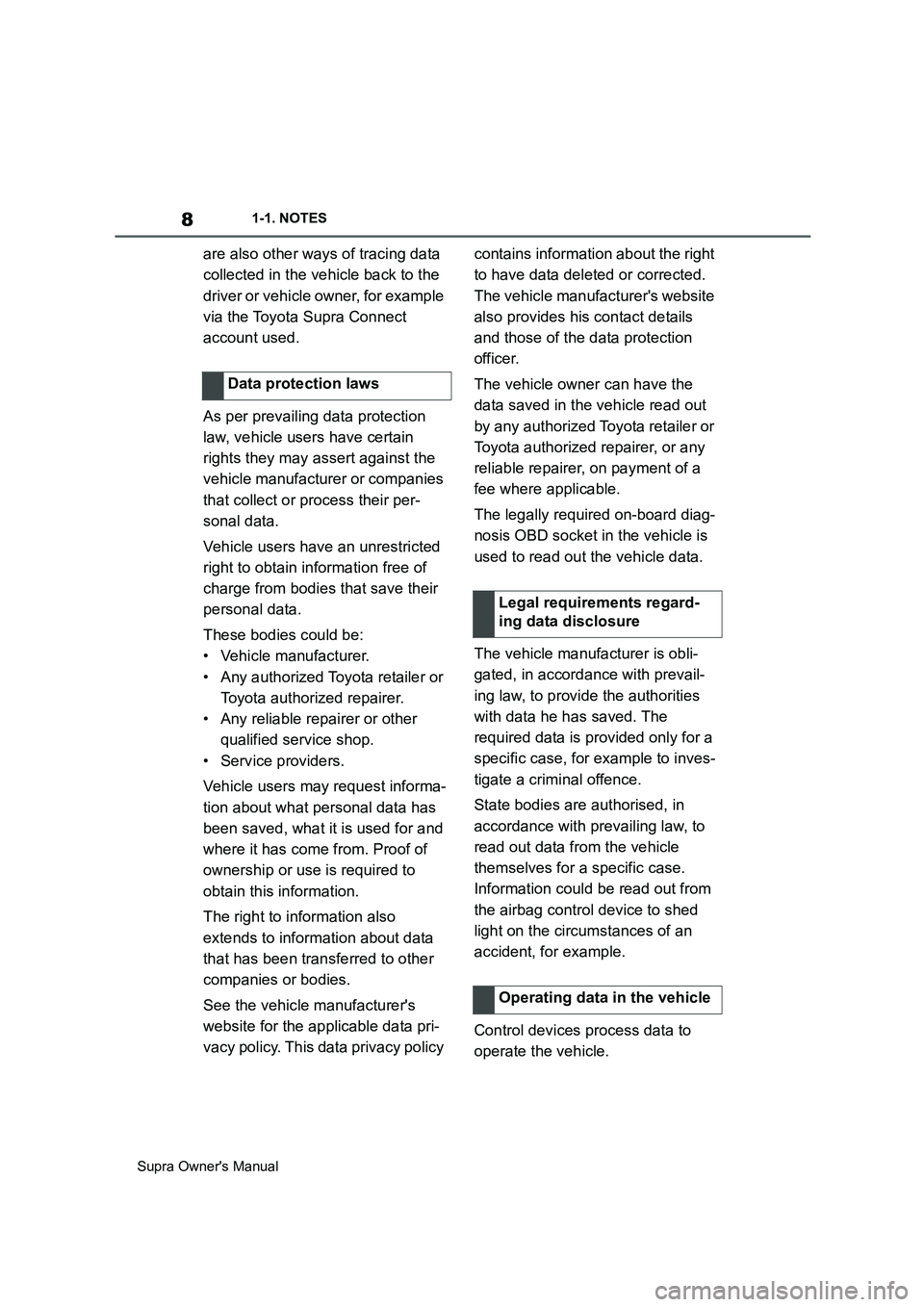
8
Supra Owner's Manual1-1. NOTES
are also other ways of tracing data
collected in the vehicle back to the
driver or vehicle owner, for example
via the Toyota Supra Connect
account used.
As per prevailing data protection
law, vehicle users have certain
rights they may assert against the
vehicle manufacturer or companies
that collect or process their per-
sonal data.
Vehicle users have an unrestricted
right to obtain information free of
charge from bodies that save their
personal data.
These bodies could be:
• Vehicle manufacturer.
• Any authorized Toyota retailer or
Toyota authorized repairer.
• Any reliable repairer or other
qualified service shop.
• Service providers.
Vehicle users may request informa-
tion about what personal data has
been saved, what it is used for and
where it has come from. Proof of
ownership or use is required to
obtain this information.
The right to information also
extends to information about data
that has been transferred to other
companies or bodies.
See the vehicle manufacturer's
website for the applicable data pri-
vacy policy. This data privacy policy contains information about the right
to have data deleted or corrected.
The vehicle manufacturer's website
also provides his contact details
and those of the data protection
officer.
The vehicle owner can have the
data saved in the vehicle read out
by any authorized Toyota retailer or
Toyota authorized repairer, or any
reliable repairer, on payment of a
fee where applicable.
The legally required on-board diag-
nosis OBD socket in the vehicle is
used to read out the vehicle data.
The vehicle manufacturer is obli-
gated, in accordance with prevail-
ing law, to provide the authorities
with data he has saved. The
required data is provided only for a
specific case, for example to inves-
tigate a criminal offence.
State bodies are authorised, in
accordance with prevailing law, to
read out data from the vehicle
themselves for a specific case.
Information could be read out from
the airbag control device to shed
light on the circumstances of an
accident, for example.
Control devices process data to
operate the vehicle. Data protection laws
Legal requirements regard-
ing data disclosure
Operating data in the vehicle
Page 43 of 456
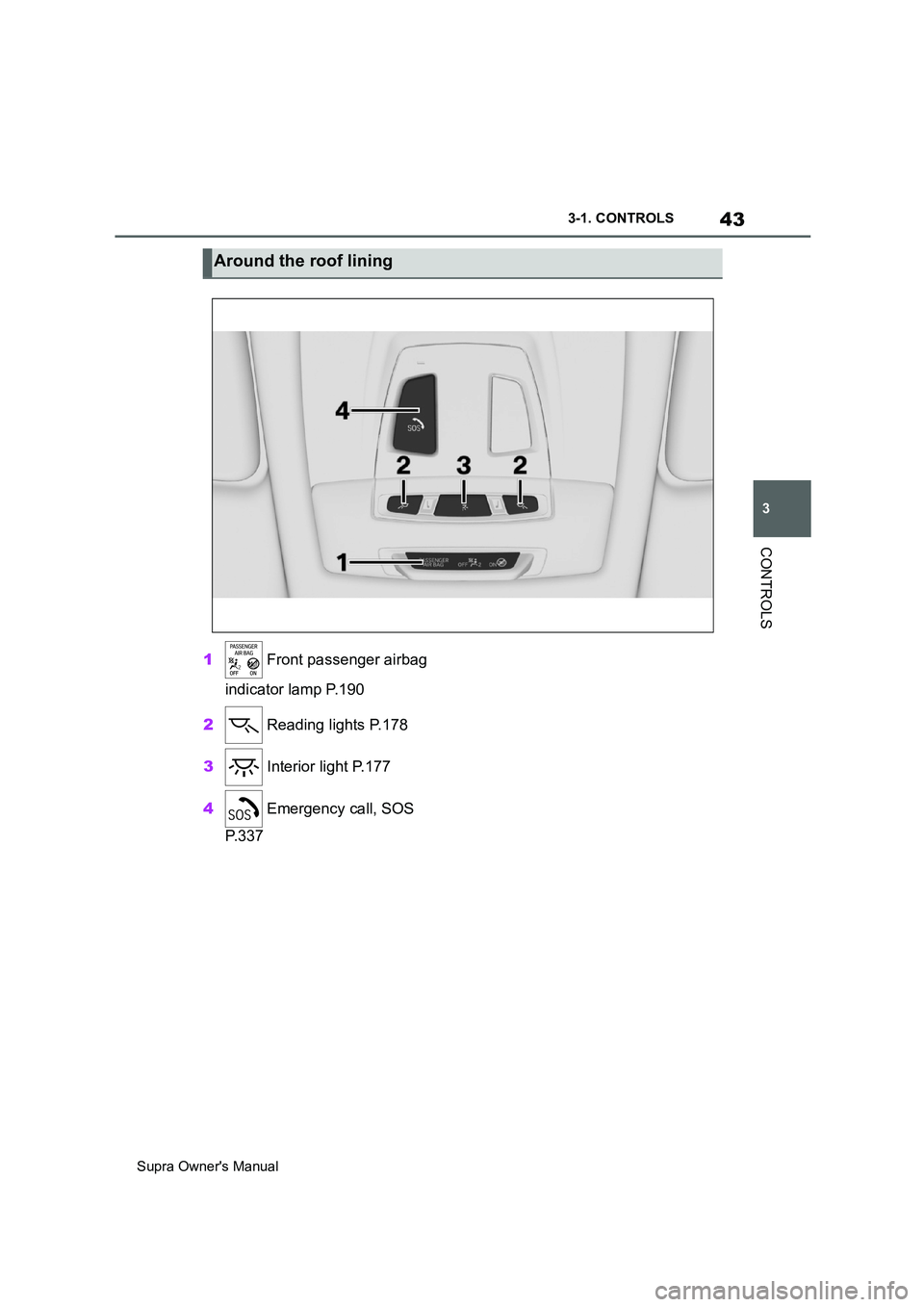
43
3
Supra Owner's Manual3-1. CONTROLS
CONTROLS
1 Front passenger airbag
indicator lamp P.190
2 Reading lights P.178
3 Interior light P.177
4 Emergency call, SOS
P. 3 3 7
Around the roof lining
Page 189 of 456

189
3
Supra Owner's Manual3-1. CONTROLS
CONTROLS
The front and side airbags for the
front passenger can be deacti-
vated and reactivated using the
integrated key from the remote con-
trol.
The key switch for front passenger
airbags is located on the outside of the
dashboard.
1Insert the key and press inwards
where necessary.
2While the key is pressed
inwards, turn it to the OFF posi-
tion as far as it will go. Once the stop position has been reached,
remove the key.
3Make sure that the key switch is
in the end position so that the
airbags are deactivated.
The front passenger airbags are
deactivated. The driver's airbags
remain active.
If a child restraint system is no
longer fitted in the front passenger
seat, reactivate the front passenger
airbags so that they are triggered
as intended in the event of an acci-
dent.
The airbag status is displayed on
the indicator lamp on the roof lining,
see page 190.
1Insert the key and press inwards
where necessary.
2While the key is pressed
inwards, turn it to the ON posi-
tion as far as it will go. Once the
stop position has been reached,
remove the key. General
Overview
Deactivating the front pas-
senger airbags
Activating the front passen-
ger airbags
Page 190 of 456
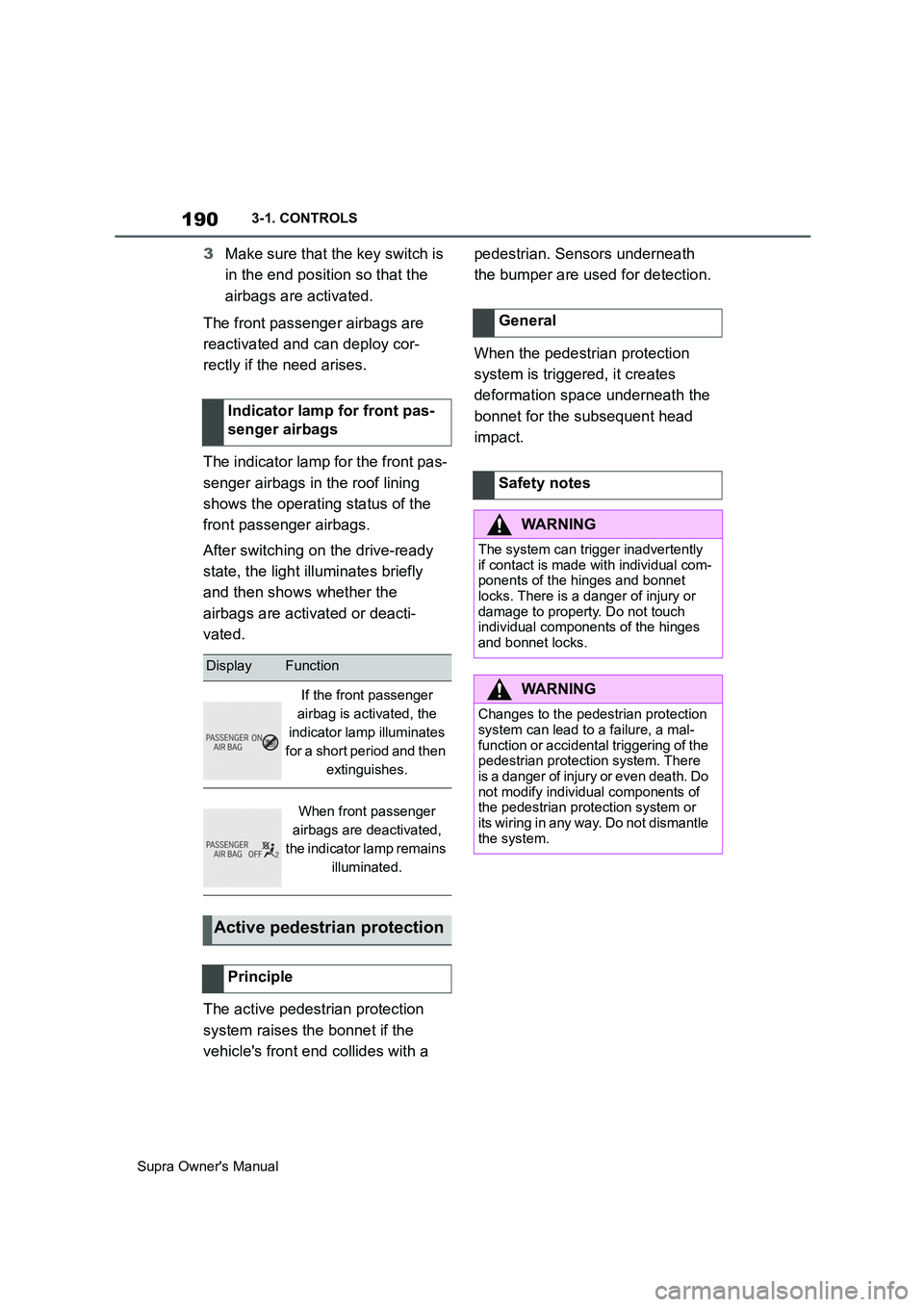
190
Supra Owner's Manual3-1. CONTROLS
3Make sure that the key switch is
in the end position so that the
airbags are activated.
The front passenger airbags are
reactivated and can deploy cor-
rectly if the need arises.
The indicator lamp for the front pas-
senger airbags in the roof lining
shows the operating status of the
front passenger airbags.
After switching on the drive-ready
state, the light illuminates briefly
and then shows whether the
airbags are activated or deacti-
vated.
The active pedestrian protection
system raises the bonnet if the
vehicle's front end collides with a pedestrian. Sensors underneath
the bumper are used for detection.
When the pedestrian protection
system is triggered, it creates
deformation space underneath the
bonnet for the subsequent head
impact. Indicator lamp for front pas-
senger airbags
DisplayFunction
If the front passenger
airbag is activated, the
indicator lamp illuminates
for a short period and then
extinguishes.
When front passenger
airbags are deactivated,
the indicator lamp remains
illuminated.
Active pedestrian protection
Principle
General
Safety notes
WARNING
The system can trigger inadvertently
if contact is made with individual com-
ponents of the hinges and bonnet
locks. There is a danger of injury or
damage to property. Do not touch
individual components of the hinges
and bonnet locks.
WARNING
Changes to the pedestrian protection
system can lead to a failure, a mal-
function or accidental triggering of the
pedestrian protection system. There
is a danger of injury or even death. Do
not modify individual components of
the pedestrian protection system or
its wiring in any way. Do not dismantle
the system.
Page 217 of 456
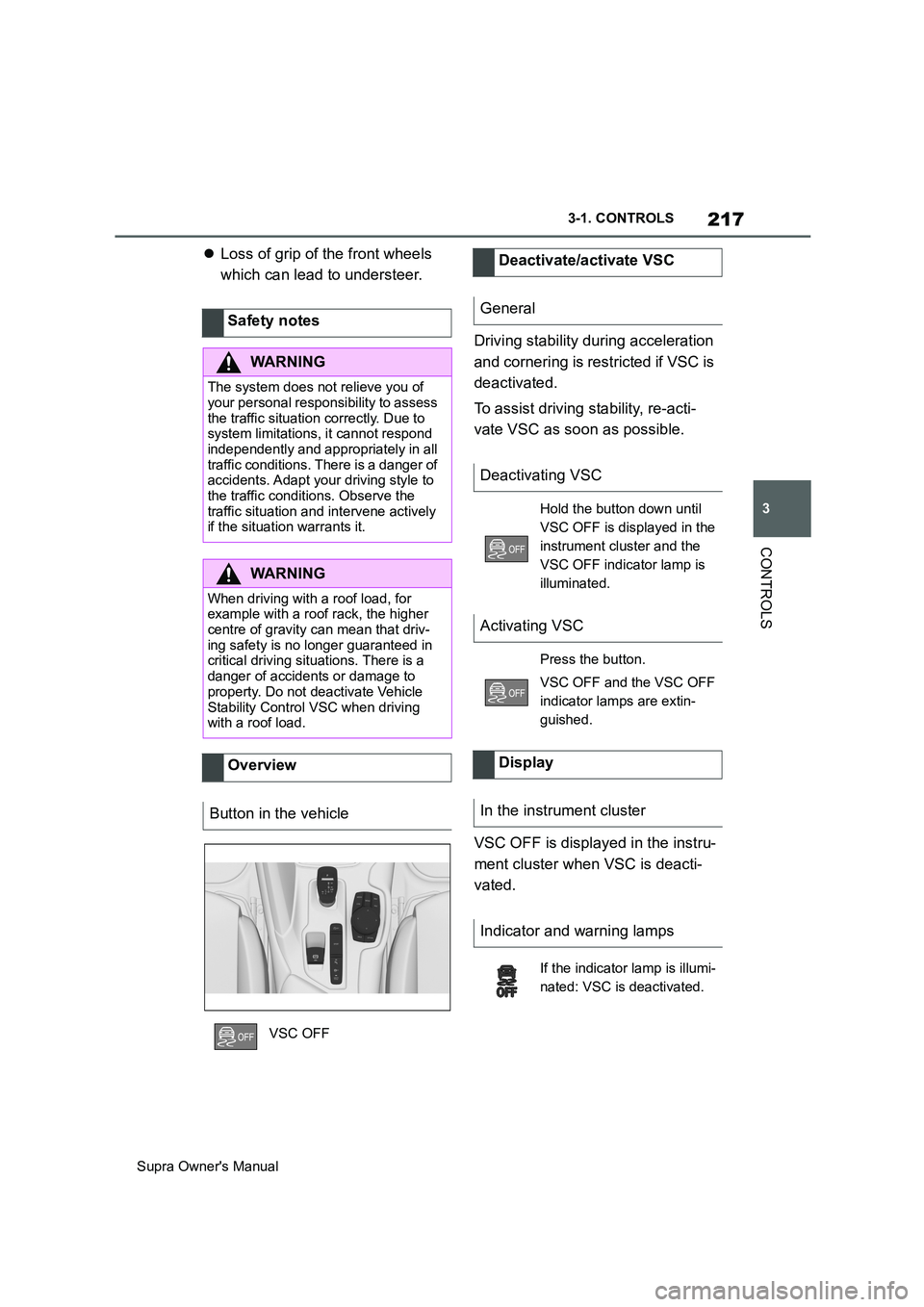
217
3
Supra Owner's Manual3-1. CONTROLS
CONTROLS
Loss of grip of the front wheels
which can lead to understeer.
Driving stability during acceleration
and cornering is restricted if VSC is
deactivated.
To assist driving stability, re-acti-
vate VSC as soon as possible.
VSC OFF is displayed in the instru-
ment cluster when VSC is deacti-
vated. Safety notes
WARNING
The system does not relieve you of
your personal responsibility to assess
the traffic situation correctly. Due to
system limitations, it cannot respond
independently and appropriately in all
traffic conditions. There is a danger of
accidents. Adapt your driving style to
the traffic conditions. Observe the
traffic situation and intervene actively
if the situation warrants it.
WARNING
When driving with a roof load, for
example with a roof rack, the higher
centre of gravity can mean that driv-
ing safety is no longer guaranteed in
critical driving situations. There is a
danger of accidents or damage to
property. Do not deactivate Vehicle
Stability Control VSC when driving
with a roof load.
Overview
Button in the vehicle
VSC OFF
Deactivate/activate VSC
General
Deactivating VSC
Hold the button down until
VSC OFF is displayed in the
instrument cluster and the
VSC OFF indicator lamp is
illuminated.
Activating VSC
Press the button.
VSC OFF and the VSC OFF
indicator lamps are extin-
guished.
Display
In the instrument cluster
Indicator and warning lamps
If the indicator lamp is illumi-
nated: VSC is deactivated.
Page 261 of 456

261
3
Supra Owner's Manual3-1. CONTROLS
CONTROLS
This chapter describes all standard,
country-specific and special equip-
ment available for the model series.
It may therefore describe equip-
ment and functions which are not
installed in your vehicle, for exam-
ple on account of the optional
equipment selected or the country
specification. This also applies to
safety-relevant functions and sys-
tems. Please comply with the rele-
vant laws and regulations when
using the corresponding functions
and systems. Safety note
WARNING
Fragile objects, for example glass
bottles or glasses, can break in the
event of an accident. Shards may
scatter throughout the interior. There
is a danger of injury or damage to
property. Do not use any fragile
objects while driving. Only stow fragile
objects in closed storage compart-
ments.
Cupholder
Safety note
WARNING
Unsuitable containers placed in the
cupholders may damage the cuphold-
ers or be flung into the interior, for
example in the event of an accident or
during braking or evasive manoeu-
vres. Spilt liquids can distract the
driver from the road and lead to an
accident. Hot beverages may damage
the cupholders or cause scalding.
There is a danger of injury or damage
to property. Do not force objects into
the cupholder. Use lightweight, seala-
ble containers that are shatterproof.
Do not transport hot drinks.
Boot
Vehicle equipment
Loads
Safety notes
WARNING
A high gross vehicle weight can make
the tyres to overheat, causing internal
damage and a sudden loss of tyre
inflation pressure. Handling charac-
teristics can be negatively influenced,
for example reduced directional sta-
bility, longer braking distance and
modified steering characteristics.
There is a danger of accidents.
Please comply with the permitted load
index of the tyre, and do not exceed
the permitted gross vehicle weight.
Page 300 of 456
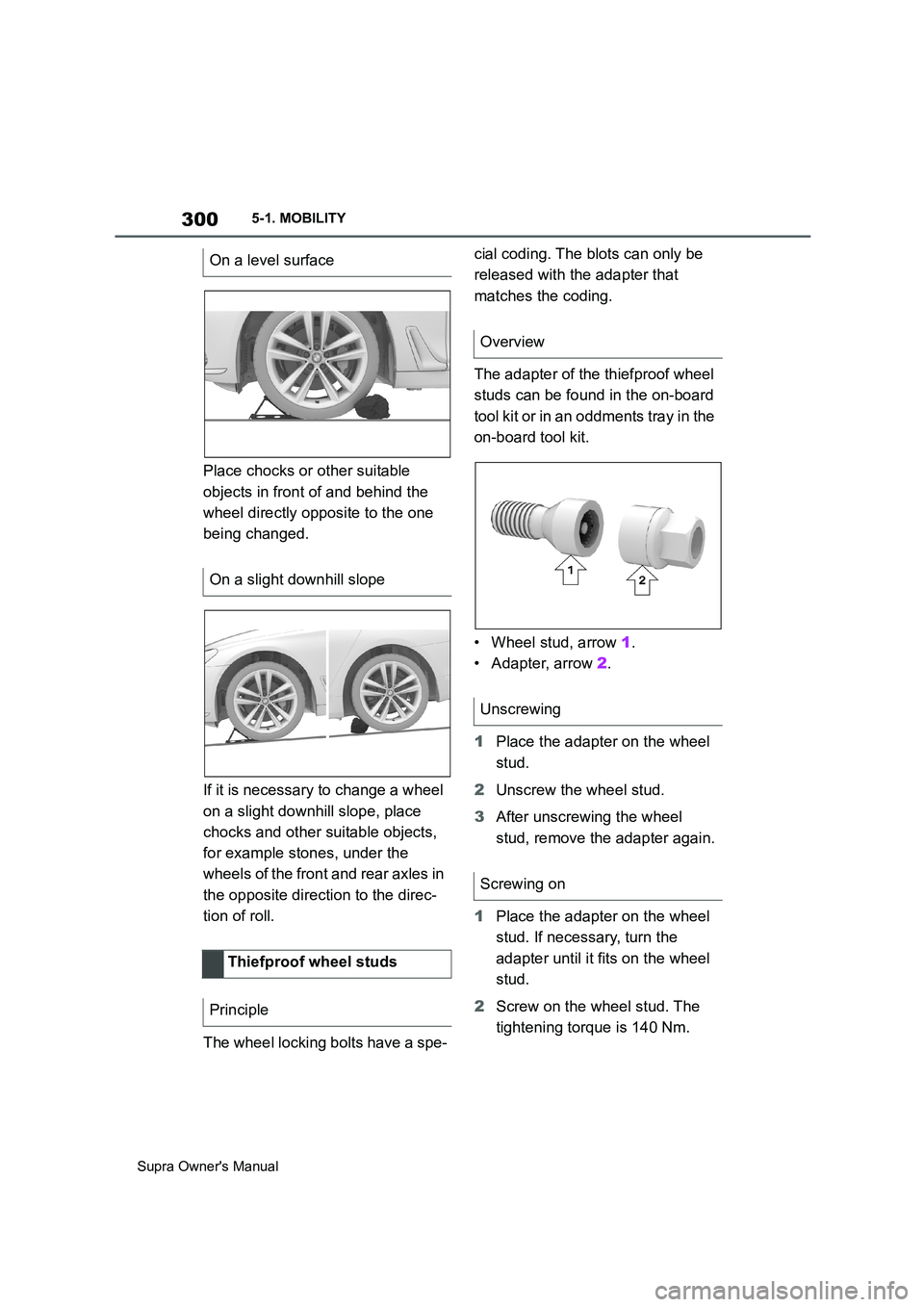
300
Supra Owner's Manual5-1. MOBILITY
Place chocks or other suitable
objects in front of and behind the
wheel directly opposite to the one
being changed.
If it is necessary to change a wheel
on a slight downhill slope, place
chocks and other suitable objects,
for example stones, under the
wheels of the front and rear axles in
the opposite direction to the direc-
tion of roll.
The wheel locking bolts have a spe-cial coding. The blots can only be
released with the adapter that
matches the coding.
The adapter of the thiefproof wheel
studs can be found in the on-board
tool kit or in an oddments tray in the
on-board tool kit.
• Wheel stud, arrow 1.
• Adapter, arrow 2.
1Place the adapter on the wheel
stud.
2Unscrew the wheel stud.
3After unscrewing the wheel
stud, remove the adapter again.
1Place the adapter on the wheel
stud. If necessary, turn the
adapter until it fits on the wheel
stud.
2Screw on the wheel stud. The
tightening torque is 140 Nm. On a level surface
On a slight downhill slope
Thiefproof wheel studs
Principle
Overview
Unscrewing
Screwing on
Page 353 of 456
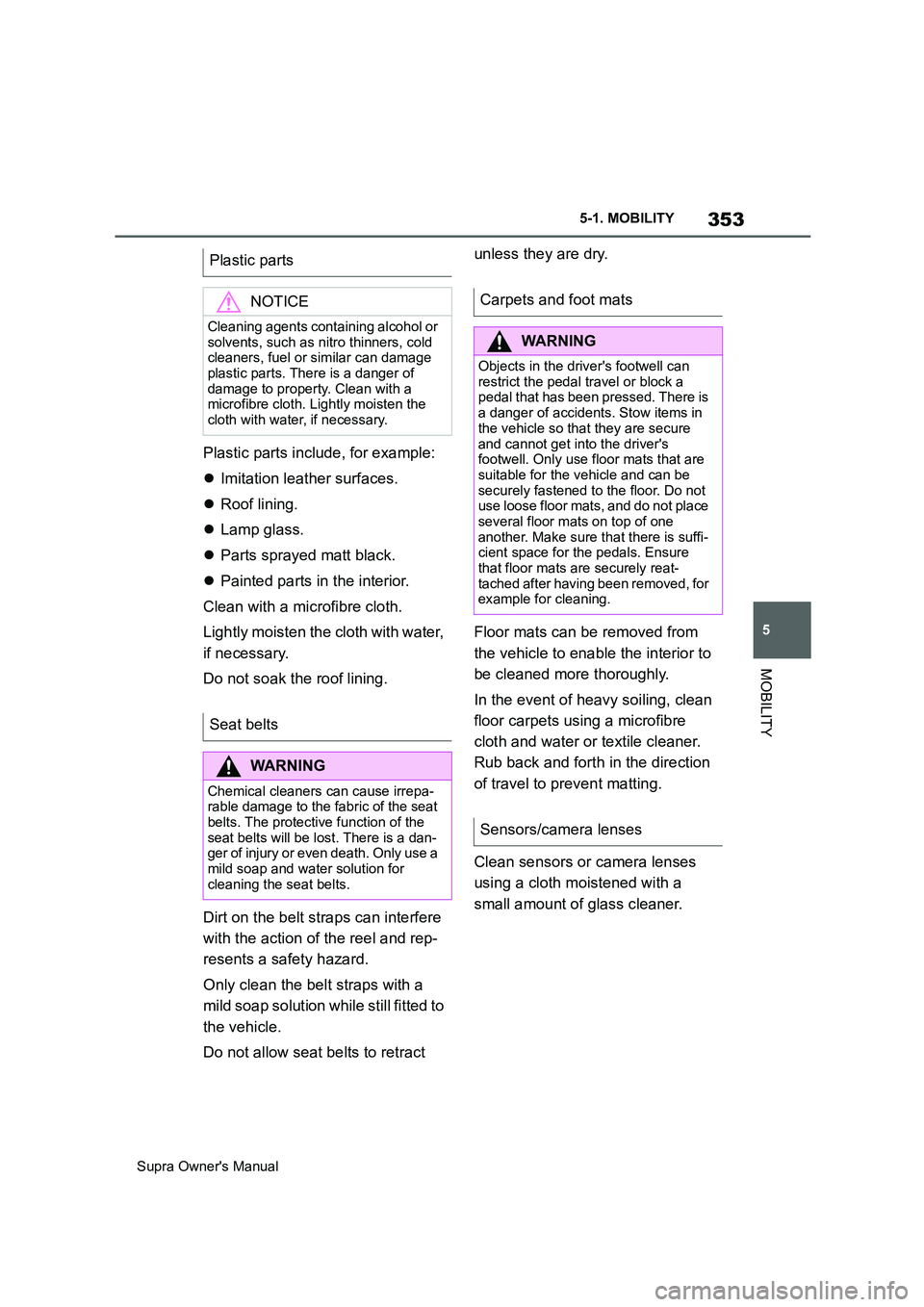
353
5
Supra Owner's Manual5-1. MOBILITY
MOBILITY
Plastic parts include, for example:
Imitation leather surfaces.
Roof lining.
Lamp glass.
Parts sprayed matt black.
Painted parts in the interior.
Clean with a microfibre cloth.
Lightly moisten the cloth with water,
if necessary.
Do not soak the roof lining.
Dirt on the belt straps can interfere
with the action of the reel and rep-
resents a safety hazard.
Only clean the belt straps with a
mild soap solution while still fitted to
the vehicle.
Do not allow seat belts to retract unless they are dry.
Floor mats can be removed from
the vehicle to enable the interior to
be cleaned more thoroughly.
In the event of heavy soiling, clean
floor carpets using a microfibre
cloth and water or textile cleaner.
Rub back and forth in the direction
of travel to prevent matting.
Clean sensors or camera lenses
using a cloth moistened with a
small amount of glass cleaner. Plastic parts
NOTICE
Cleaning agents containing alcohol or
solvents, such as nitro thinners, cold
cleaners, fuel or similar can damage
plastic parts. There is a danger of
damage to property. Clean with a
microfibre cloth. Lightly moisten the
cloth with water, if necessary.
Seat belts
WARNING
Chemical cleaners can cause irrepa-
rable damage to the fabric of the seat
belts. The protective function of the
seat belts will be lost. There is a dan-
ger of injury or even death. Only use a
mild soap and water solution for
cleaning the seat belts.
Carpets and foot mats
WARNING
Objects in the driver's footwell can
restrict the pedal travel or block a
pedal that has been pressed. There is
a danger of accidents. Stow items in
the vehicle so that they are secure
and cannot get into the driver's
footwell. Only use floor mats that are
suitable for the vehicle and can be
securely fastened to the floor. Do not
use loose floor mats, and do not place
several floor mats on top of one
another. Make sure that there is suffi-
cient space for the pedals. Ensure
that floor mats are securely reat-
tached after having been removed, for
example for cleaning.
Sensors/camera lenses